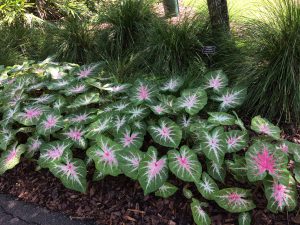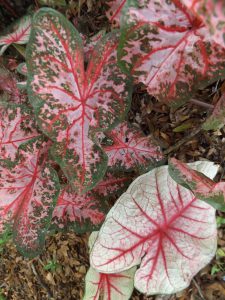 Caladiums are tuber plants in the Araceae family, which are best known for their fabulous foliage. Even if you have what is construed to be a “brown thumb”, you will be pleasantly surprised at the ease of the cultivation of these bulb plants.
Caladiums are tuber plants in the Araceae family, which are best known for their fabulous foliage. Even if you have what is construed to be a “brown thumb”, you will be pleasantly surprised at the ease of the cultivation of these bulb plants.
The humid, hot climate of central Florida provides a perfect spot to grow caladiums. Most of the caladiums used throughout the world are produced in Florida. In fact, many varieties of caladiums are grown commercially in the Highlands County area around Sebring and Lake Placid. Caladiums made their way to America by way of greenhouses in Europe. They are originally from the Amazon Basin.
UF/IFAS initiated a caladium breeding program in 1976, at the Gulf Coast Research and Education Center. As of now, this has been the only major organized caladium breeding program in the world. When the breeding program was started, the main objectives were to develop new cultivars that are able to produce many bright colorful leaves and a high yield of good quality tubers, as well as, have short, sturdy petioles and multi-eyed tubers that can result in increased early leaf production and improved leaf display. There are three additional goals of this program which are to: 1) improve the aesthetic values and performance of caladium plants in containers and landscapes; 2) improve tuber and plant productivity and profitability; and 3) eliminate the costly labor associated with tuber de-eyeing.
In hardiness zones 8-11, it is possible to plant caladiums with foliage throughout the year in partial shade. It is advisable to postpone any planting until all possible chance of frost has passed, with soil temperature at least 60 – 70 degrees Fahrenheit. As for the tubers, you can plant them between April and September in north and central Florida. In south Florida they may be planted a month earlier.
According to UF/IFAS Gardening Solutions, the proper method of cultivation is to place the tubers (also called bulbs) “eye side” up. The eye side is identified by its knobby, puckered appearance.
Caladiums perform well in well-drained, moist soil. This will require frequent watering, being careful to not overwater. Too much water may result in fungal disease. Towards the end of the growing season gradually reduce the amount of water you provide to assist in the dormancy of the plant.
Mulching is recommended but wait until the leaves have appeared so that they do not have to fight their way through the mulch.
If you live in an area with sandy soils, you may apply a light application of fertilizer a couple of times per growing season. If you have rich soils, you may forego the fertilizer if desired. Avoid over-fertilizing as leaf color will be impacted and you may lose the beautiful vibrant colors.
Unless your caladiums are becoming too thick, there is no need to divide them. If you begin to develop the problem of the leaves becoming sparse, you will need to replace and replant your bulbs as they naturally decline with age.
Although caladiums bear a cream-colored flower which resembles the bloom of a calla lily, it is the vibrant colors of the foliage that is the real showstopper. Caladiums bear leaves in an amazing array of colors, patterns, and leaf shapes. Leaf colors include pink, white, green, chartreuse, rose, burgundy and red. You may view some of the varieties in Caladium Cultivars Developed at the UF/IFAS. The publication will tell you which named cultivars provide certain colors. For instance, if red is your preferred leaf color, try Cherry Tart, Sizzle, Red Hot and Royal Flush.
Caladiums do well potted or planted in the landscape. They will deliver a pop of color in your shade garden and are nearly impossible not to notice.
This article was written by Master Gardener Volunteer Debra Howell under supervision of the Master Gardener Volunteer Coordinator and Residential Horticulture Agent Anne Yasalonis.
For more information, contact UF/IFAS Extension Polk County at (863) 519-1041 or visit us online at http://sfyl.ifas.ufl.edu/polk. The Plant Clinic is open Monday-Friday, 9:00 am-4:00 pm to answer your gardening and landscaping questions. Give us a call, or email us at polkmg@ifas.ufl.edu.
If you are not in Polk County, Contact your local UF/IFAS Extension Master Gardener Volunteer Plant Clinic.
The Florida Master Gardener Program is a volunteer-driven program that benefits UF/IFAS Extension and the citizens of Florida. The program extends the vision of the University of Florida/Institute of Food and Agricultural Sciences, all the while protecting and sustaining natural resources and environmental systems, enhancing the development of human resources, and improving the quality of human life through the development of knowledge in agricultural, human and natural resources and making that knowledge accessible.
An Equal Opportunity Institution.
 1
1
